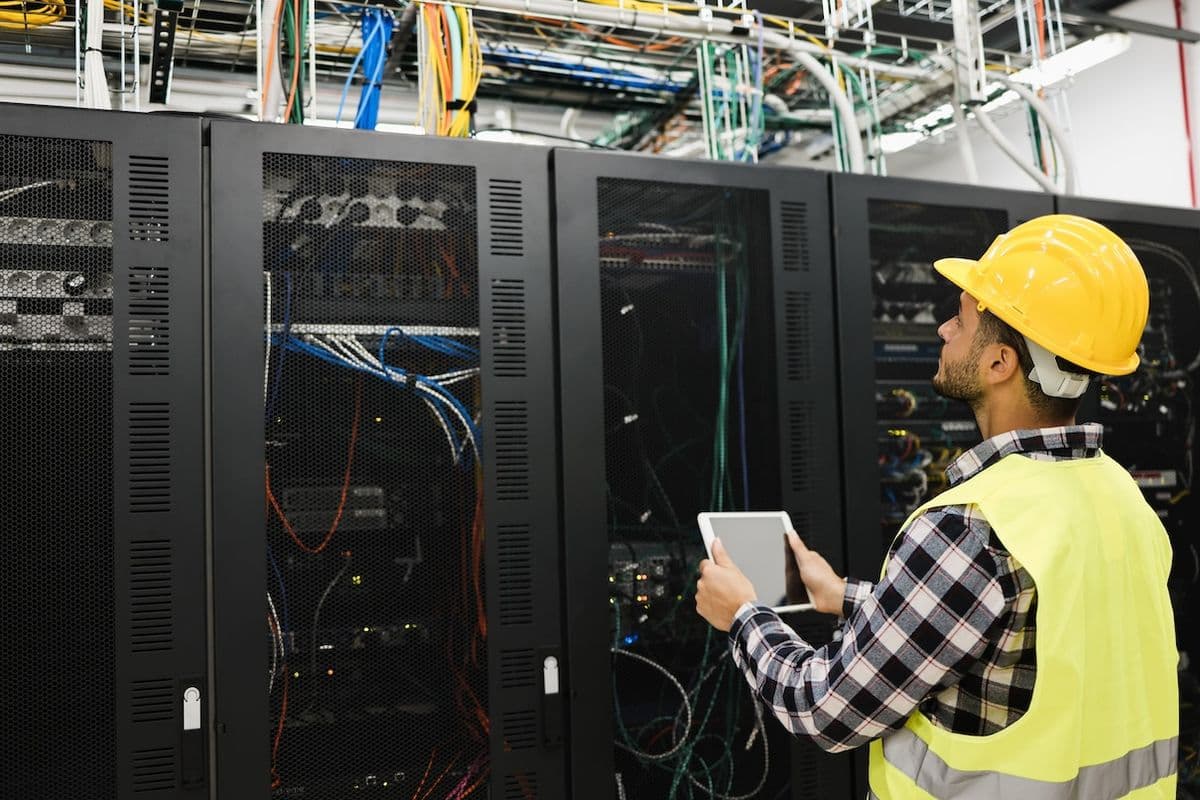Key Insights for Construction Leaders
- Centralized procurement isn't just about saving money, it's about gaining control. By consolidating purchasing, companies can command better prices, reduce maverick spending, and ensure consistency across all projects.
- Technology, especially platforms like Archdesk, transforms procurement from a bottleneck into a strategic advantage. It automates workflows, provides real-time visibility, and integrates with existing systems, freeing up project managers to focus on building.
- The shift from decentralized to centralized or hybrid models is a journey, not an overnight switch. Phased implementation, starting with high-spend categories and demonstrating tangible benefits, is crucial for overcoming resistance and ensuring success.
You know that feeling? The one where you’re juggling six different projects, and suddenly, a material delivery for one site is late, a subcontractor invoice on another doesn't quite match the quote, and then it hits you—you bought the same light fixtures from two different suppliers at wildly different prices. It's a mess, isn't it? And that mess isn't just stressful; it quietly eats away at your profit margins until you’re left scratching your head, wondering where all the money went.
For many construction firms, the answer isn't just working harder; it’s about working smarter with a centralized procurement strategy. It’s about turning that chaos into clear, actionable financial gains.

A construction business team collaborating in an office setting.
The Hidden Costs of "Just Getting By"
Let's be honest, how many companies buy stuff is, well, a bit unorganized. When every project manager is out there making their own deals, you completely lose your collective buying power. It’s like everyone in a big family going to the grocery store separately – nobody gets the bulk discount, and you end up with ten different brands of ketchup, none of which were on sale. This decentralized way of doing things often leads to uncontrolled spending, inconsistent pricing, and a mountain of administrative overhead just to keep track of it all. You're essentially leaving money on the table before the first shovel even hits the dirt.
In an industry where margins are already tight, sometimes hovering around 5-10%, these "small" inefficiencies become big problems. They can be the difference between a project that truly thrives and one that just breaks even, or worse.
What's the Buzz About Centralized Procurement?
It’s simpler than it sounds, honestly. Centralized procurement simply means bringing all your purchasing under one roof. Instead of ten project managers calling ten suppliers, a dedicated team—or even just a dedicated software platform—handles the buying for the entire company. This team negotiates master service agreements, secures bulk pricing on common materials, and ensures every purchase order follows the same, optimized process.
Think of it as the difference between a pickup basketball game and a team with a well-coached playbook. One is reactive, often relying on individual heroics; the other is strategic, coordinated, and aims for consistent wins.
The Direct Link to Your Bottom Line
So, how does centralizing procurement actually put more money in your pocket? It really boils down to a few big wins that stack up across all your projects.
Serious Cost Savings on the Table
Consolidating your spending gives you leverage, pure and simple. Suppliers are far more likely to offer better rates when they see the sheer volume of business you can bring them. This isn't about squeezing them; it’s about building stronger partnerships based on predictable, larger-volume orders. That discount on rebar or drywall might seem small per unit, but across multiple projects over a year, it adds up to a massive impact on your gross margins. For example, in regions like the Nordics or the GCC, where supplier costs can account for up to half the total project budget, even small percentage savings multiply quickly.
Slashing Administrative Waste
How many hours are your project managers spending chasing quotes, processing invoices, and manually matching documents? With a centralized system, much of that can be automated. Purchase orders are generated from approved budgets, invoices are matched electronically, and approvals happen in a streamlined workflow. This frees your valuable site managers to actually manage their sites, not paperwork. It turns lost hours into billable ones, or at least, hours spent on critical project oversight.
Gaining Real-Time Visibility and Control
You can’t fix what you can’t see. Centralized procurement gives you a single dashboard to track spending across all active jobs. You can spot budget overruns the moment they happen, not three months later when the project is finished and the damage is done. This allows for proactive adjustments, helping you protect that all-important project margin before it’s too late. It transforms budgeting from a hopeful guess into a managed, dynamic process.
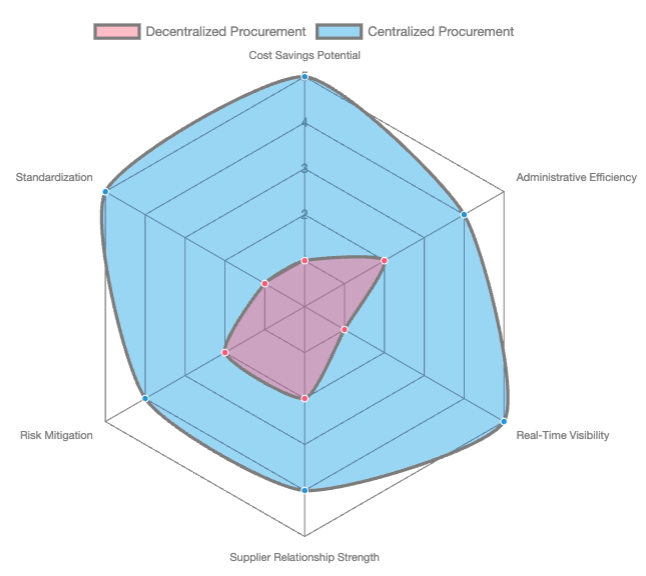
This radar chart illustrates a comparative analysis of key benefits between decentralized and centralized procurement models. Centralized procurement consistently scores higher across metrics like cost savings potential, administrative efficiency, real-time visibility, supplier relationship strength, risk mitigation, and standardization, highlighting its strategic advantages for construction firms aiming to improve margins.
Moving Beyond the 'Old Way'
Now, I can almost hear the objection: “But every project is unique! My guys need flexibility!” And you’re absolutely right. The goal isn’t to create a bureaucratic bottleneck. The best modern systems are built for flexibility. You can set approval thresholds so site managers can handle small, urgent buys while the central team manages major orders. It’s about establishing control without sacrificing necessary agility.
The trick is using technology as your foundation. A proper construction procurement platform acts as your central nervous system, connecting everyone without slowing them down. It’s the playbook that ensures everyone is running the same plays, but with the autonomy to call an audible when the situation demands it.
The Archdesk Advantage: Your Smart Procurement Partner
This is where smart software really shines, and honestly, Archdesk is built for this. It helps you manage all aspects of construction procurement from one place. Imagine having a system that tracks material orders, subcontractor agreements, and project budgets in real time. Archdesk centralizes your procurement by managing everything from material orders to subcontractor agreements. It provides customizable material workflows, real-time budget tracking, purchase order management, accurate invoice matching, and vendor management. You can manage every aspect of the procure-to-pay process, from budget analysis and contract negotiation to invoice payment.
Compared to broad construction suites like Procore or Autodesk Construction Cloud, which are great for overall project management, Archdesk focuses harder on the procurement spine and cost control. It integrates seamlessly with accounting platforms and even offers an open API for custom integrations, so it fits right into your existing operations. This means less manual work, fewer errors, and more time for your team to focus on building, not paperwork. It’s like having a super-efficient assistant who never forgets a detail.
What I really like about Archdesk is how it makes the procure-to-pay process straightforward without overwhelming users. You can create purchase orders, manage suppliers, and analyze costs across projects with ease. Teams often report substantial savings, sometimes up to 20% on procurement, because it quickly highlights inefficiencies. Plus, its open API means it plays nice with your existing setup, whether you're dealing with manufacturing tie-ins or straight-up building.
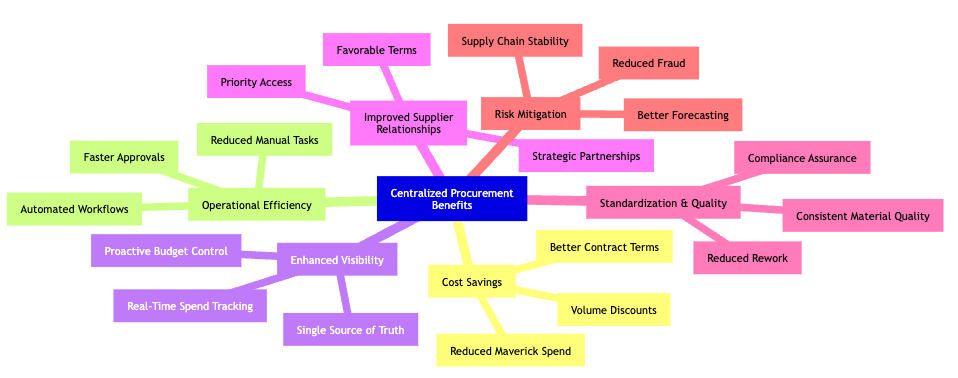
This mindmap visually outlines the comprehensive benefits of adopting a centralized procurement strategy in construction. It branches out from the core concept to show how it positively impacts various aspects of a business, including cost savings, operational efficiency, enhanced visibility, improved supplier relationships, standardization, and risk mitigation.
Tackling the Challenges Head-On
Of course, no system is perfect, and implementing centralized procurement can face some initial pushback. Site managers, used to their autonomy, might ask, "Why fix what ain't broke?" It’s a fair question. The key is to address these concerns by showing them the wins—how it frees them from administrative drudgery, gives them access to better quality materials, and prevents project delays due to procurement issues. Comprehensive training helps, too; maybe start small, with one project, demonstrate tangible benefits, and then scale up.
Cost is another hurdle, but think long-term here. The initial setup pays for itself through the accumulated savings and efficiencies. And in today's world, with a growing trend towards sustainable building, centralized buying lets you prioritize eco-friendly suppliers, which can open doors to green incentives and better bids, ultimately boosting your appeal and bottom line.
How Centralized Procurement Elevates Project Margins
Improving profit margins on your projects isn't a one-time fix; it’s an ongoing process. It starts with truly understanding your costs inside and out. With a centralized procurement system, you can see all your expenses, compare them against your estimates, and pinpoint exactly where you might be losing money. Regularly reviewing and updating costs is absolutely crucial.
Impact of Centralized Procurement on Margin Improvement Factors
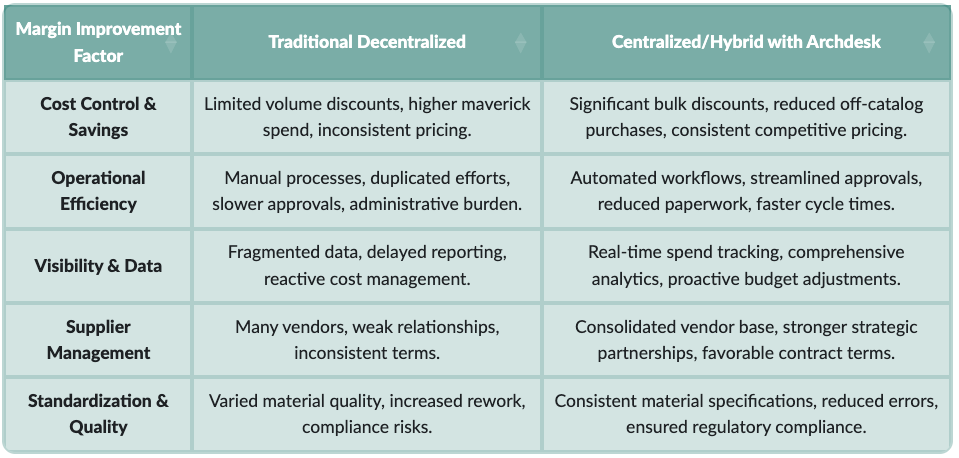
This table highlights the stark differences in how centralized procurement, especially when supported by a platform like Archdesk, positively impacts key margin improvement factors compared to traditional decentralized approaches. It demonstrates a clear shift from reactive, inconsistent management to proactive, strategic control.
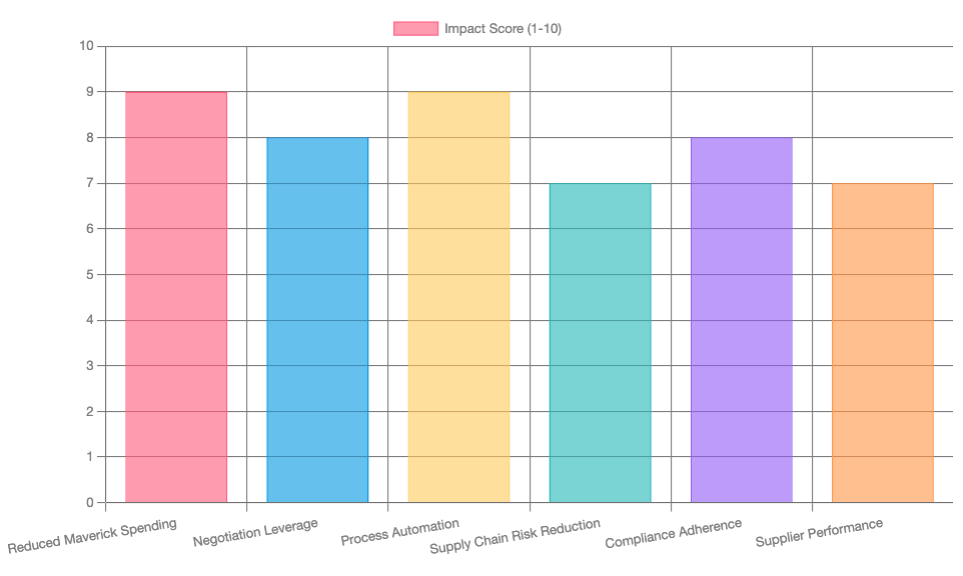
This bar chart evaluates the specific areas where centralized procurement delivers the most significant impact on a scale of 1 to 10. It highlights "Reduced Maverick Spending" and "Process Automation" as particularly strong contributors, followed closely by "Negotiation Leverage" and "Compliance Adherence," all of which directly contribute to improved project margins.
Small Moves, Big Impact
- Accurate Cost Estimates: Good data from past projects, easily accessible through a centralized system like Archdesk, helps you create much more precise bids. This means you’re less likely to underbid and end up with slim margins.
- Track Everything: And I mean everything. Every bill, every expense, as it happens. Archdesk’s budget tracking and real-time spend visibility mean you’re never surprised by costs. You can quickly see which tasks have the biggest impact on profitability.
- Operational Efficiency: The faster and smoother your processes, the better your margins. Centralized procurement cuts down on redundant tasks and approval bottlenecks. This translates directly to reduced administrative costs and faster project completion.
- Stronger Vendor Relationships: We touched on this before, but it's worth repeating. Leveraging stronger supplier relationships through consolidated purchasing allows for better negotiation power and more favorable terms. This directly reduces your material and service costs.
- Data, Data, Data: Knowing which projects are most profitable, and why, helps you make smarter decisions about future work. Archdesk gives you those insights, allowing you to focus on the work that truly drives your business forward.
Honestly, in an industry where margins are always tight, finding a reliable way to cut costs and boost efficiency isn’t just a good idea—it’s a survival tactic. Centralizing your procurement might just be the most straightforward step you can take to ensure your business isn’t just busy, but truly profitable.
Frequently Asked Questions
What exactly does "centralized procurement" mean for a construction company?
Centralized procurement means that one dedicated team or department manages all purchasing activities across all your construction projects. Instead of each project manager buying independently, all material, equipment, and subcontractor purchases are funneled through a single, coordinated process. This helps in securing better deals, standardizing processes, and gaining better control over spending.
Will centralizing procurement slow down my project teams?
Not necessarily. While it's a common concern, modern centralized procurement systems, like Archdesk, are designed with flexibility in mind. They allow for streamlined, automated workflows for routine purchases and set clear approval thresholds, ensuring that urgent, smaller buys can still be made quickly by site teams, while larger strategic purchases benefit from central oversight. The goal is efficiency and control, not bureaucracy.
How does Archdesk specifically help improve project margins through procurement?
Archdesk integrates the entire procure-to-pay process, from requisitions and RFQs to purchase orders, delivery tracking, and invoice matching. It provides real-time budget control, allowing you to see commitments and actuals against cost codes instantly. By centralizing supplier management, pricing catalogs, and approval workflows, Archdesk helps reduce maverick spending, secure volume discounts, and improve administrative efficiency, all of which directly contribute to healthier project margins.
What's the difference between a fully centralized and a hybrid procurement model?
A fully centralized model means all purchasing decisions go through a single department. A hybrid model, often preferred by larger contractors, involves a central team managing policies, key categories, approved supplier panels, and analytics, while individual projects handle day-to-day requests within those established rules. This approach balances the benefits of central control with the need for project-level flexibility and speed.
Is an initial investment in procurement software worth it for improving margins?
Absolutely. While there's an initial cost to implementing new software, the long-term savings and efficiency gains often far outweigh this investment. By reducing material costs, eliminating administrative overhead, preventing budget overruns, and improving supplier relationships, the software helps you retain more profit on each project, making it a strategic investment for sustainable growth.
Final Thoughts
Centralized procurement isn't just about micromanaging; it's about empowering your team to protect margins across every project. It transforms potential losses into tangible gains, keeps your cash flow steady, and ultimately allows you to bid more competitively. If you’re a construction CEO staring at slim profits, or an employee tired of procurement headaches, it might be time to give it a shot. Tools like Archdesk can get you there without the usual struggle. After all, in construction, every dollar saved is a dollar earned – and that's the kind of math that helps build lasting businesses.
References
Archdesk Solutions: Procurement - Archdesk
How to streamline procurement with Archdesk - LinkedIn
Centralized Purchasing: Definition, Benefits & Process
The 7 Best Construction Procurement Software Tools | Archdesk Blog

